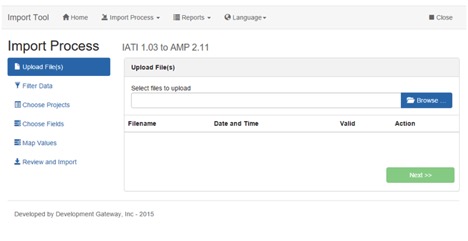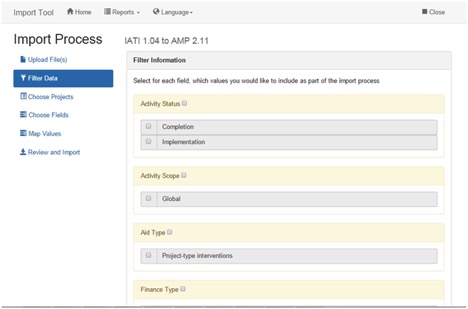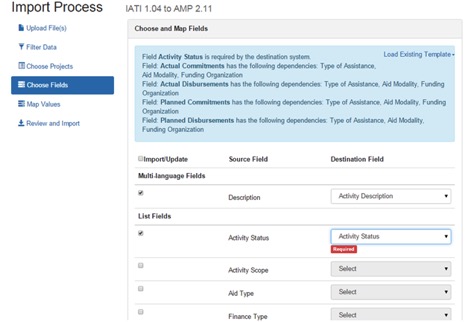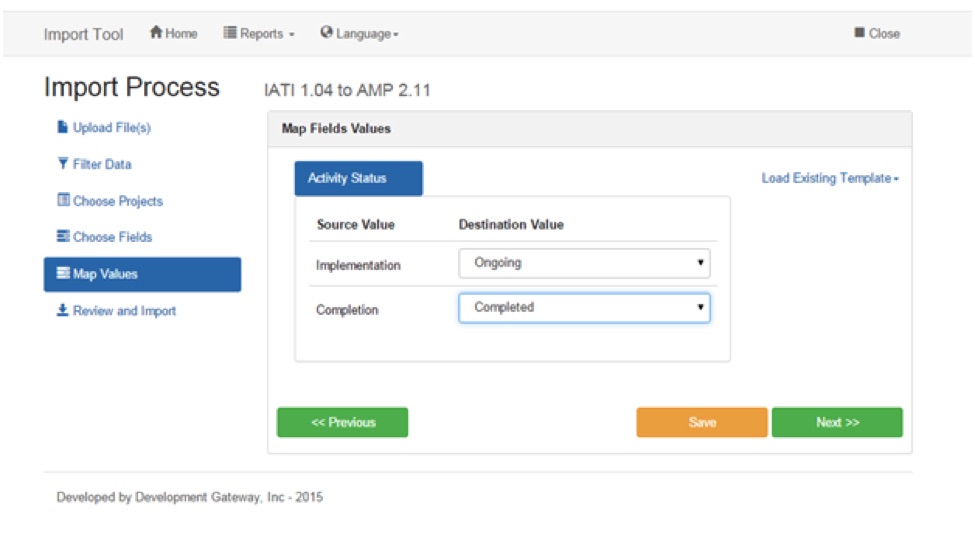Development Gateway Launches the IATI Import Tool
Since the launch of the IATI Data Standard, DG has been in the forefront in promoting its uptake and use – particularly amongst national governments.
A little over a year ago, we began a program which sought to create sustainable integrations of IATI data across five nationally-owned Aid Information Management Systems (AIMS). One of the outcomes of this work were recommendations around proposed enhancements to the data standard and improvements to publisher quality.
Another result of this work, we are proud to share, has been the development of an open source IATI Import Tool, available to the public via GitHub.
Fully integratable with AIMS – Aid Management Platforms and other systems – the tool has already been used to import hundreds of millions of dollars of additional aid flow data into the AIMS of Burkina Faso, Chad, Cote d’Ivoire, Madagascar, and Senegal. Furthermore, this tool can be updated to support new versions of the IATI Standard, and now comes as a standard part of DG’s Aid Management Platform.
Technology and Architecture
The IATI Import Tool has been developed using the Spring Framework on the backend and ReactJS library on the frontend. The Spring Framework provides a comprehensive programming and configuration model for developing modern Java-based enterprise applications. ReactJS is an open source JavaScript library that makes it easy to develop reusable user interface components.
The tool has a flexible architecture, designed specifically to make the tool easily adaptable to future IATI versions and different AIMS. This flexibility is achieved through the use of data processing modules called “processors”. New processors can be added to support any source data or destination system.

The integration to an AIMS is done via REST API endpoints. Documentation of the endpoints that the AIMS system should provide is available on the IATI Import Tools’ GitHub page.
User Workflow
The IATI Import Tool has a user friendly user interface that is organized as a wizard, which takes users through the following steps:
Step 1: Source Input

The source input is uploaded into the system and processed. Currently we support IATI 1.03, IATI 1.04, IATI 1.05 and IATI 2.01. This can be easily expanded to support other types of data files, too – IATI and otherwise.
Step 2: Filter Data

The source activity/project information is then parsed and processed. The user can select the criteria of inclusion in the import process from a list of known fields, like “Status”, “Recipient Country”.
Step 3: Choose Projects

After applying filters, the next step returns only projects/activities that match the applied filters. In this step, a user can select which projects/activities to import. The user can also map the projects to existing projects in the destination system.
Step 4: Choose Fields
Users can now select and map fields that will be included in the import. The user can also save mappings for use in future imports.
Step 5: Mapping Values

This step allows users to map field values in the source file to values used in the destination system. These value mappings can be saved as a template, then selected from the “Load Existing Template” menu. This uses the previous mappings with the new file’s field values.
Step 6: Importing

Once the source files are processed and filtered, and their projects, fields, and values are mapped the destination system is contacted through a series of REST Endpoints with the new and/or updated project information
Get Involved
The IATI Import Tool is licensed under an Apache 2.0 open-source license, now comes as a standard part of the Aid Management Platform, and is compatible with other AIMS. If you are interested in using or extending the tool you can get it on our GitHub repository. Please also check the wiki for additional documentation on how to integrate the tool with a target system, and let us know about your experiences!
Share This Post
Related from our library

Building a Sustainable Cashew Sector in West Africa Through Data and Collaboration
Cashew-IN project came to an end in August 2024 after four years of working with government agencies, producers, traders, processors, and development partners in the five implementing countries to co-create an online tool aimed to inform, support, promote, and strengthen Africa’s cashew industry. This blog outlines some of the key project highlights, including some of the challenges we faced, lessons learned, success stories, and identified opportunities for a more competitive cashew sector in West Africa.

Launching a Partnership Matching Service for Nonprofits
While a lot of us have talked about the potential, value, and – in some cases – need for more mergers and acquisitions in the non-profit space, recent events have made it clear: now is the time. That’s why the teams at Accountability Lab, Development Gateway: An IREX Venture and Digital Public, partnered up to develop both a new toolkit, a partnership matching service, and professional support infrastructure aimed at assisting the organizations facing this challenge.

Digital Transformation for Public Value: Development Gateway’s Insights from Agriculture & Open Contracting
In today’s fast-evolving world, governments and public organizations are under more pressure than ever before to deliver efficient, transparent services that align with public expectations. In this blog, we delve into the key concepts behind digital transformation and how it can enhance public value by promoting transparency, informing policy, and supporting evidence-based decision-making.